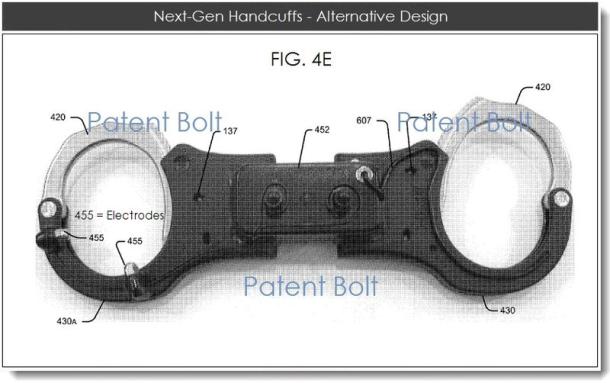Will handcuffs of the future zap you into submission?


An interesting new patent might make you think twice about breaking the law.
Our guns are equipped with lasers, our missiles lock-on targets, and we can even spy on people through autonomous drones. But our physical restraints remain in the dark ages, forged of little more than steel and unlocked with metal keys.
At least, until now.
A new patent discovered by Patent Bolt, filed by Scottsdale Inventions, might herald the next generation of restraining devices. Titled "Apparatus and System For Augmented Detainee Restraint," a new set of handcuffs aims to "administer electrical shocks when certain predetermined conditions occur," and can be "activated by internal control systems or by external controllers that transmit activation signals to the restraining device."
Through location-tracking technology, for example, a prisoner could receive an automatic shock if attempting to go to an unauthorized location, if they try to tamper with the handcuffs, there is "an utterance by the detainee that exceeds a predetermined volume" -- better make sure you don't shout or swear, then -- or they exit from an area without leave.
The idea of handcuffs that can shock you into behaving might be going far enough, but that's not the end of the story. If the warning a detainee receives isn't heeded, and being zapped isn't enough, the patent also mentions a technique which allows the police to remotely inject a substance into the prisoner through a "substance delivery system."
"The substance includes at least one of a liquid, a gas, a dye, an irritant, a medication, a sedative, a transdermal medication, a chemical restraint, a paralytic, a medication prescribed to the detainee, and combinations thereof," the patent states.
Although this new patent is mainly focused on handcuffs, the description says that it could also be modified for inclusion in ankle cuffs, restraining belts, straightjackets, harnesses, neck collars and even facial restraints.
A fine line, certainly, especially if a police officer decides to induce one of the aforementioned "paralytics." Let's just hope such restraints, if made available, are used wisely.
(via Patent Bolt)
Related: The results of Wiki Weapons gun testing | Bionic mannequins spy on you as you shop | Should we 'ban killer robots before it's too late'? | Driving drones.. how boring. | Why nothing is private: How the FBI can read your emails | The $199 camera that captures your every moment |
This post was originally published on Smartplanet.com